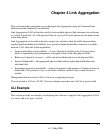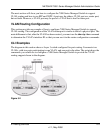
5-1
v1.1, May 2006
Chapter 5
IP Routing Services
IP routing services are divided into five areas:
• Port Routing
• VLAN Routing
• Routing Information Protocol (RIP)
• Open Shortest Path First (OSPF) Protocol
• Proxy Address Resolution Protocol (ARP)
Port Routing
The first networks were small enough for the end stations to communicate directly. As networks
grew, Layer 2 bridging was used to segregate traffic, a technology that worked well for unicast
traffic, but had problems coping with large quantities of multicast packets. The next major
development was routing, where packets were examined and redirected at Layer 3. End stations
needed to know how to reach their nearest router, and the routers had to understand the network
topology so that they could forward traffic. Although bridges tended to be faster than routers,
using routers allowed the network to be partitioned into logical subnetworks, which restricted
multicast traffic and also facilitated the development of security mechanisms.
An end station specifies the destination station’s Layer 3 address in the packet’s IP header, but
sends the packet to the MAC address of a router. When the Layer 3 router receives the packet, it
will minimally:
• Look up the Layer 3 address in its address table to determine the outbound port
• Update the Layer 3 header
• Recreate the Layer 2 header
The router’s IP address is often statically configured in the end station, although the 7000 Series
Managed Switch supports protocols such as DHCP that allow the address to be assigned
dynamically. Likewise, you may assign some of the entries in the routing tables used by the router
statically, but protocols such as RIP and OSPF allow the tables to be created and updated
dynamically as the network configuration changes.


















